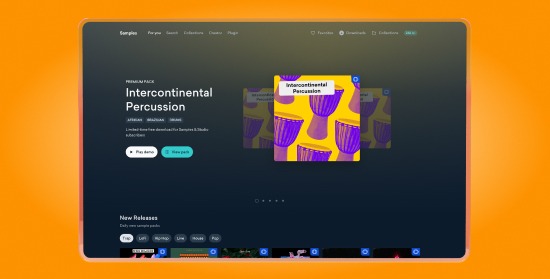26 Samples Tips: The A-Z of Using Samples in Your Music Production

Samples are some of the most powerful tools in your music production arsenal.
They’re bits of sound that you can chop, loop, stack on top of each other, and manipulate any way you want.
In this article we’re breaking down the A-Z of tips, tricks and techniques to help you work better with samples.

A. ADSR
ADSR stands for attack, decay, sustain, release.
These are the controls you’ll find on a sampler’s envelope generator.
Manipulating your envelopes can have radical effects.
B. Breakbeats
A breakbeat is a type of sample that a contains drum or rhythm pattern from an existing track—usually vintage funk or R&B.
They’re called breakbeats because early hip-hop producers could only sample isolated beats during instrumental “breaks” just the drums were playing.
The most famous breakbeat is the Amen Break.
C. Crate-digging
Crate-digging is the old school practice of rummaging through the crates of vinyl records at a record store to find unique material to sample.
You can still crate-dig in the digital domain by browsing samples and using Selector to find unique combinations.
D. Distortion
Distortion is a powerful effect.
Downsampling, bit-crushing, clipping and other forms of sonic destruction are great for turning boring samples into something completely different.
Don’t be afraid to get your hands dirty!
E. EQ
EQ is for equalization.
There’s no rules when it comes to EQing samples.
Sometimes you need to use EQ to stop your tracks from masking each other.
Other times EQ is a creative tool for taking your sounds in a completely new direction.
F. Filters
Most samplers and sampler plugins have integrated filters.
Try using them as a tone-shaping tool before you reach for other types of processors.
Samples can sound completely different when radically filtered by high-or low-pass filters.
G. Gated reverb
Gated reverb is a combination of reverb and a noise gate.
When the reverb tail decays below the threshold of the gate, the sound is abruptly cut off.
It’s the famous technique behind the super punchy 80s drum sound, but it can create unique ambience on samples too.
H. Hardware sampler
Samples don’t just live in your DAW.
Getting your hands on a hardware sampler can change your workflow in a way you might not expect.
Classics like the Akai MPC and Korg Electribe will always be useful tools for music producers.
I. Interpolation
Stretching a single sample across the entire keyboard is an old school technique for pitch-shifted polyphonic playback.
But often it’s not very realistic.
Enable the interpolation setting on your sampler to increase the quality of the pitch-shifted samples.


J. Jamming
Jamming is an informal term for improvised performance and live collaboration.
You can sample improvised music performances live or from records.
Collaborating with other musicians can be a form of jamming.
K. Kits
Drum kits are a basic building block in music production.
The term “drum kit” comes from a traditional live drummer setup.
Today a drum kit can refer to collections of percussion samples meant to be used together.
L. Loop
Loops and looping are an essential part of any samples workflow. Loop samples can be easily stretched and manipulated to create a composition. Setting loop points within a sample in your sampler plugin can also yield inspiring results.
M. MIDI
MIDI stands for Musical Instrument Digital Interface.
It’s the language that digital music devices use to communicate.
Experiment with different ways to manipulate the MIDI that triggers your samples. Or trying using a MIDI controller to play your samples live.
N. Noise
In most cases you want to minimize noise in your recordings.
But sometimes noise can be the sonic glue that holds your mix together.
Using samples of vinyl pops and crackles or atmospheric noise is a great way to extend ambience without adding more tonal elements.
O. One-shot
One-shots are samples that are only played through once, instead of looping.
One-shots can refer to any type of “hit,” from a quick vocal ad-lib, to a synth tone, to a drum kick.
In most production situations you’ll have a mix of loops and one-shot samples.
P. Polyphony
Polyphony means more than one note at a time.
A sampler is polyphonic if it can play a sample or set of samples on multiple keyboard keys at once.
Using polyphonic mode on your sampler can open up harmonic possibilities you didn’t even know were there—try it!
Q. Quantize
Quantizing is used to bring MIDI note events into time on the DAW grid.
But you can get much more creative with it if you throw the rule book out the window.
Many producers prefer a touch of imperfection, to make things feel more human.
Try quantizing to a groove to get a bit of that human feel into your samples.
R. Resample
Resampling means taking your sampled sounds and…sampling them again.
Applying processing and effects can turn a sample into something completely different.
Resampling commits your tweaked sound to a new sample and lets you start fresh—and take it even further.


https://www.youtube.com/embed/SEJ0WN043zY
S. Slicing modes
Many hardware and plugin samplers include a slicing mode for chopping samples into smaller segments that can be retriggered and manipulated.
Common slicing functions include creating slices based on grid divisions or transients detected in the source sample.
Slicing can make even the most mundane samples come alive.
T. Timestretch
Timestretching refers to slowing down or speeding up a sample.
It’s usually used when you want to modify the tempo of a particular sample.
Timestretching can have a radical impact on a sample’s pitch and quality. Try using it creatively for an effect.
U. Upsample
Upsampling, also called “oversampling” is when you process a sample at a higher sample rate.
Some plugins can do this to improve the quality of the processing they apply.
V. Vintage sampler plugins
The limited storage and primitive AD/DA conversion of vintage samplers gave them a unique sound.
You can get some of this vintage flavour for yourself with plugins that model the classics.
Try using plugins such as TAL Sampler, Sonic Charge Cyclone or 112 dB Morgana to add that perfect retro grittiness to your samples.
W. Wave Editor
Some sampler plugins have a built-in wave editor for fine tuning your source samples.
Try editing your samples directly at the waveform level using a wave editor.
X. X-fade
X-fade stands for crossfade.
Enable X-fade on looped samples in your sampler plugin to ensure they loop seamlessly without clicks or artifacts.
Y. Y-cable
A Y-cable is used to create parallel signal chains with hardware like effects pedals.
But you can do the same thing with samples in your DAW.
Experiment with different parallel and serial effects chains for radical new textures.
Z. .zip
A .zip file is an archived or compressed file format.
You might use .zip or .rar files for transferring or downloading stems and sample packs.
